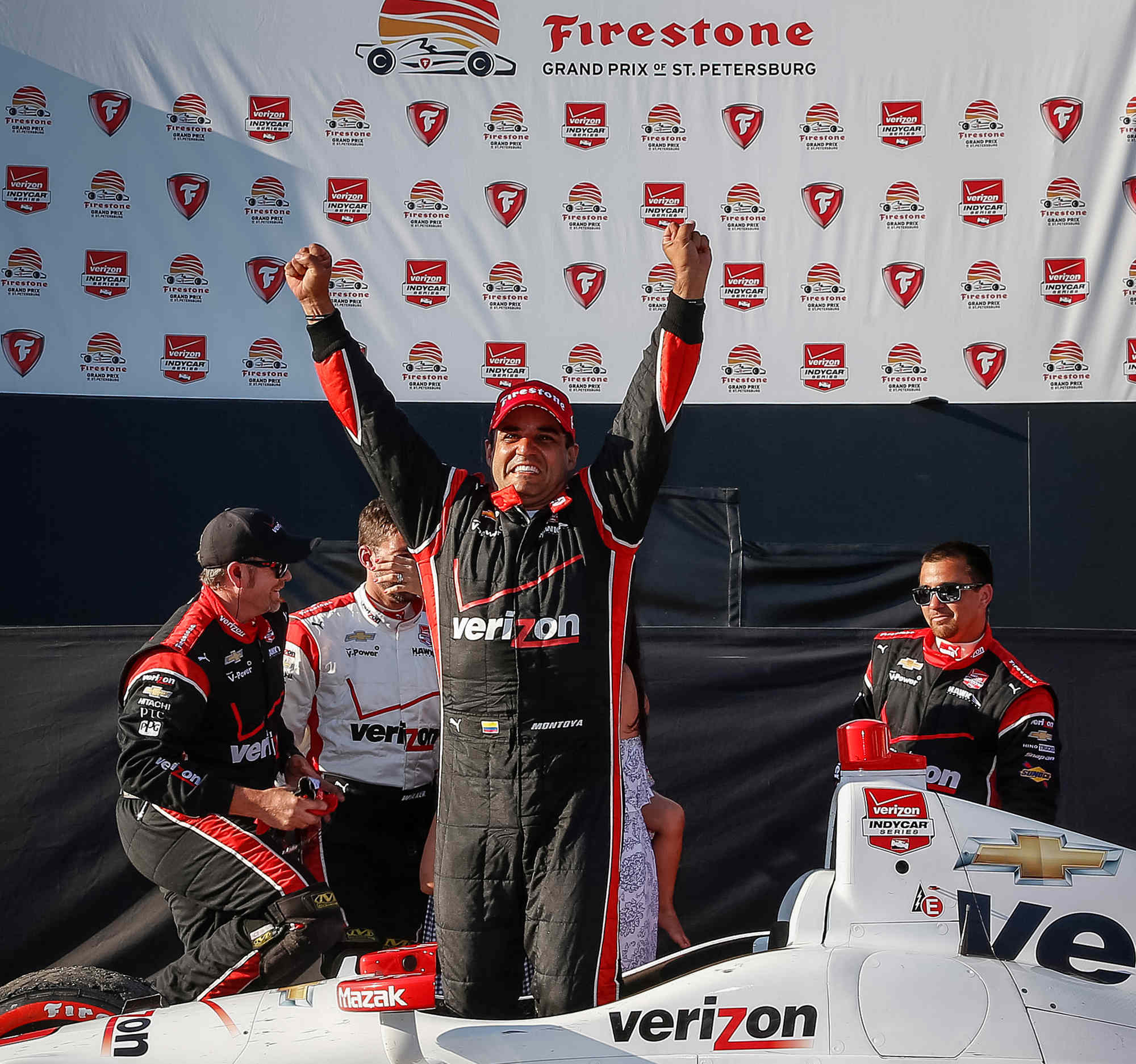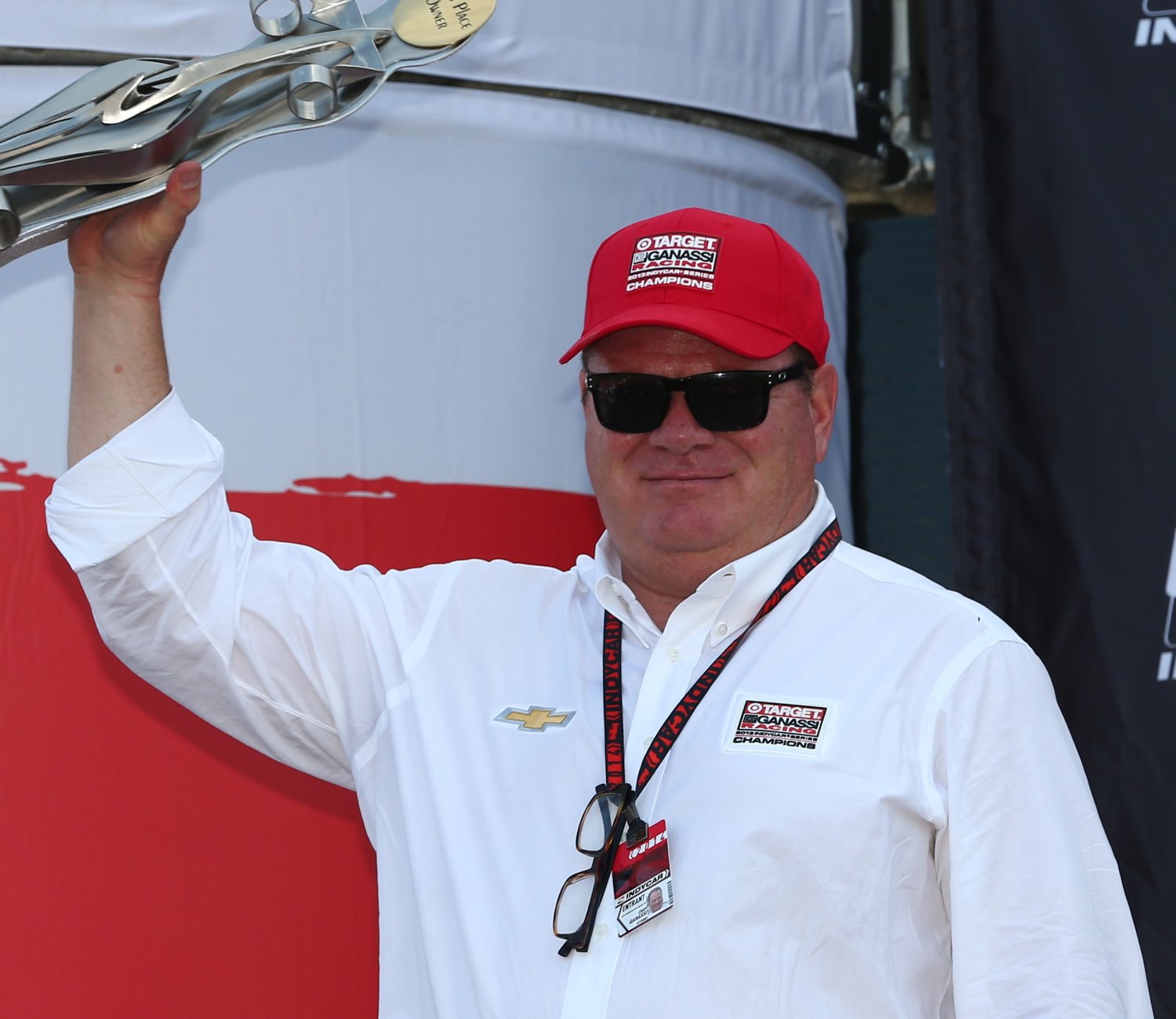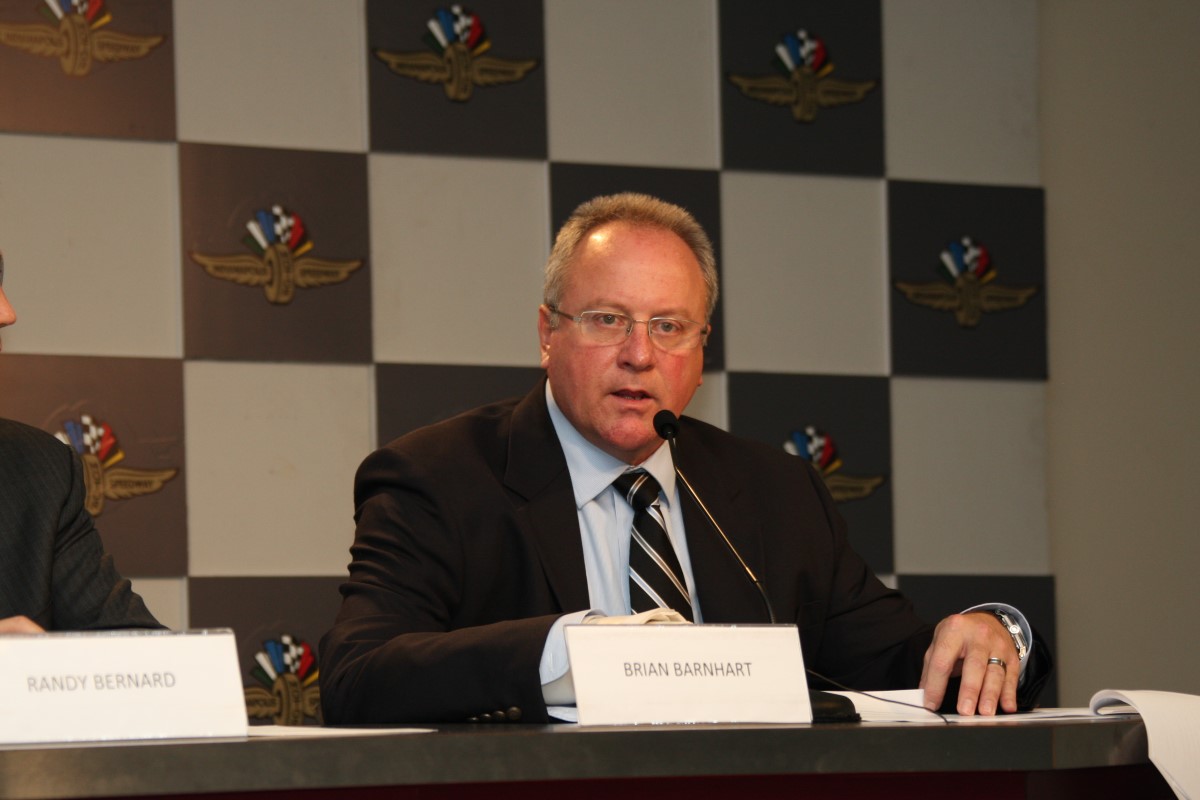IndyCar: St. Petersburg Postscript
 |
| Penske ace Juan Montoya |
Saturday, the very formidable four-car Team Penske armada swept the top-4 positions in qualifying for the Firestone Grand Prix of St. Petersburg. Defending series champion Will Power taking pole, with Simon Pagenaud second, Helio Castroneves third and Juan Pablo Montoya fourth. Then, in Sunday’s race Montoya would emerge ahead of Power during the final round of pit stops to hold on for the victory, with Power second, Castroneves fourth and Pagenaud fifth. Chip Ganassi Racing’s Tony Kanaan broke up a Penske race sweep finishing third.
Yes, aside from Kanaan crashing the Penske parade, it was a clinic in complete and thorough domination from Indy Car racing’s most-storied team.
That, I know.
What I can’t get my head around, is how exactly to interpret what we saw from Team Penske over weekend. Yes, it’s only one race, and Team Penske is a perennial force. However, the extent of Penske’s dominance resembled nothing of the relative parity that has defined the Verizon IndyCar Series in recent years. In 2014, for example, 11 drivers from 7 teams visited victory lane in 19 races. In each of the past three seasons small-budget Dale Coyne Racing has scored a victory.
[adinserter name="GOOGLE AD"]Now, I suppose other teams may soon bridge at least part of the gap that existed between themselves and Team Penske. However, from where I was sitting there was not one shred of evidence from this weekend suggesting that is imminent. No, this was a comprehensive butt-kicking by Team Penske, which begs the question: what are we potentially looking at from Team Penske in 2015?
Well, given that Sunday’s race bore little resemblance to the recent past, it might behoove us to go back and take a look at a time in the distant past when Indy Car racing truly witnessed domination by one team. And there should be no surprise who the dominant team was then.
1994
In 1994, what was then known as Marlboro Team Penske won 12 of 16 races between three drivers: Al Unser, Jr. (8), Paul Tracy (3), and Emerson Fittipaldi (1). Unser, Jr. won the series championship and Indy 500, and the three drivers also finished 1-2-3 in the then PPG Indy Car World Series Championship (Unser-Fittipaldi-Tracy). The team’s thorough domination is possibly best illustrated by five 1-2-3 finishes in 16 races.
Yes, there have been dominant teams and/or drivers before. Some decried the domination we saw in the final years of the pre-DW12 IRL. However, that was either Penske-Ganassi-Andretti dominance, or Penske-Ganassi dominance. In essence, it was multiple teams, Penske being one, taking the lion’s share of wins. In my lifetime at least, there was no Indy car season in which one team seemed to dominate as Penske did in 1994.
So, are we potentially looking at another 1994?
To find out let us go back to 1994, and compare Team Penske’s competition then to now.
The Competition
Without question, the class of 1994 featured more ‘big name’ drivers than the current crop. Part of that was because IndyCar was more popular then than now. Still, you had previous world champions Nigel Mansell and Mario Andretti driving for powerhouse Newman/Haas. A future world and Indy car champion in Jacques Villeneuve was a rookie. Also, previous Indy car champions Michael Andretti and Bobby Rahal were in the field.
However, Mansell at the time was on the north side of 40 years of age, and quickly deteriorating into something of a petulant diva after a magical Indy Car debut in 1993. Mario Andretti was in his final season, and while as competitive as any 54-year-old can be certainly not the driver of his prime. Villeneuve won that year’s Elkhart Lake round but was a rookie driving for a new team Forsythe/Green Racing.
Thus, one could argue Penske benefitted from an aging Newman/Haas driver lineup, and young drivers like Villeneuve, Robby Gordon and future series champ Jimmy Vasser all looking to establish themselves in the series.
As Newman/Haas, who had captured the 1991 and 1993 series championships was somewhat in transition in 1994, so was Target Chip Ganassi Racing.
During the 1993-1994 offseason, TCGR pulled off something of a coup in signing then-F1 refugee Michael Andretti, after Andretti endured a disappointing season as Ayrton Senna’s teammate at McLaren. ‘Mikey’ scored Ganassi’s first victory in a not-yet superior Reynard-Ford at Surfers Paradise in the opener, then later that season at Toronto. However, Ganassi then was an emerging front-runner in the process of establishing itself as a top-tier team.
Rahal had won the championship in 1992. But like Mansell, Rahal was also on the north side of 40, and further hindered by a then woefully-underpowered Honda engine.
In essence, Indy Car racing featured some bigger names in 1994, although part of that was a function of Indy Car racing being far more popular. However, some of those bigger names were on the downside of their careers and/or the teams they drove for were in transition. Without taking away from Penske’s exceptional, Penske PC-23/Ilmor D chassis/engine package and they’re impressive lineup of drivers which thoroughly defeated the competition; I’d argue there were more factors working in the team’s favor in 1994 than now.
Speaking of Now
 |
| Can Chip Ganassi raise his team's game and take it to the Penske juggernaut? |
While Penske’s four cars clearly got the better of the field Sunday, there is another big difference between now and then. In 2015, Ganassi and two other teams have the same Chevy aero-kit parts, Chevy engine and Dallara DW12 that Penske has. In 1994, Penske and only Penske had the PC-23 chassis. Penske may have come out of the gate with an advantage but Ganassi has shown in recent seasons they can adjust during the year.
Also, Ganassi boasts one of this generation’s best in Scott Dixon, and the baseline of 10 Indy car style championships since 1996. Dixon, who had a rather lackluster weekend in St. Pete, has shown himself to be stronger in the second half of seasons in recent memory.
Elsewhere in the Chevy stable, KV Racing Technology has a four-time Indy car champion in Sebastien Bourdais, and oval ringer in Ed Carpenter for CFH Racing, who has given both Penske a Ganassi a run for their money on oval tracks in recent seasons. And while Carpenter only runs part-time in the oval races, his part-time status, and the go-for-wins approach of that team, makes Carpenter a threat to steal race victories from Penske. Again, Team Penske did not have the threat of a part-time mercenary without the concern of racing for points in 1994 that they do in 2015.
One area it does seem Penske has a clear advantage is Chevy over Honda. While anyone who knows that proud company, questions Honda at their own risk, Chevy clearly has the early edge in performance and certainly has the edge in driver/team depth.
And while Honda seems to be behind Chevrolet, both in terms they have a four-time championship team in Andretti Autosport, and an in his prime Ryan Hunter-Reay.
Dixon, Bourdais, Carpenter, and Hunter-Reay are examples of established race-winning Indy car drivers in their prime years. Further, Dixon, Bourdais, and Carpenter all have the exact same parts and engine Penske has.
In short, Penske has come out of the box with a clear edge, and has to be the favorite to win the championship. However, this will likely not be a situation like 1994, where the team is essentially battling amongst itself. They face a field of stiffer competition in 2015, that has access to the same resources they do, and one of those teams in particular (Ganassi) has a proven track record of figuring out how to best utilize said materials, particularly during the second half of the season.
Yes, we could be looking at Penske supremacy. No, I don’t think we’re looking at another 1994.
Kits
Prolonged periods behind the pace car cleaning up bits and pieces of carbon fiber or whatever else scattered across the race track clearly isn’t good for business. That said, having parts of the car launch into the spectator area on the far side of a grandstand no less, is potentially catastrophic. While the track operator would certainly incur some of the burden and legal expense in such a scenario, I could see a good lawyer, or a not so good, showing that the car itself was faulty.
To put it mildly, it was not a great debut for the much-anticipated Chevrolet and Honda aero kits. And the simple truth is something needs to be done quickly about all these dangling parts shattering and scattering at high speeds. Because dare we say, everyone was lucky this weekend to have gotten away with only a fractured skull.
BB
 |
| Brian Barnhart |
I’ve said this before, I’ll say it again. The issue with Brian Barnhart in Race Control is not the bad calls he often makes. The issue with Barnhart is that from a public perception standpoint, he is incapable of being right.
To be clear, my intention here is not to filet Barnhart. I don’t know Barnhart and while I question some calls he has made in the past, this is not an attack on him personally. I simply believe that because his motives and competence will always be questioned Barnhart’s presence in Race Control, fair or unfair, is an untenable scenario.
And while Barnhart’s return to Race Control didn’t blow up during the first race weekend, we saw instances of the issues he and the series will face going forward, in the incident between Graham Rahal and Charlie Kimball.
Kimball, of course, sustained damage to his right rear tire cover after he was hit from behind by Simon Pagenaud. The contact slowed the #83 Chevy, although not to the point that other cars were able to overtake Kimball through the tight section passing the Mahaffey Theatre into Turn 11. Rahal attempted to pass Kimball in turn 11, and there was not room for both. Contact between the two saw Kimball wind up in the tire barrier, resulting in a full-course caution. Rahal would be assessed a drive-thru penalty for ‘avoidable contact.’
[adinserter name="GOOGLE AD"]Now, personally I think the fact Kimball was wounded makes Rahal’s situation subject to interpretation. Had Kimball not been wounded it would have been an easy to assess Rahal a penalty for punting the 83 into the tires. However, if Rahal’s contact was avoidable with Kimball wounded, then Pagenaud’s contact from behind with Kimball unwounded was certainly avoidable.
Of course, a skeptic might point out that Barnhart was a former Penske employee, and during his ignominious first stint in Race Control from 1997-2011, was known to be somewhat partial to his former employer.
Now, am I saying he was partial to Penske here? No. However, the fact it is even a discussion makes my larger point: Barnhart’s motives and fairness will always be questioned, just as will his competence or lack thereof. And the problem with Barnhart is not the fact he is often wrong, the problem is a climate exists in which he is incapable of being right.
Brian Carroccio is a senior motorsports columnist for AutoRacing1. He can be contacted at BrianC@AutoRacing1.com.
